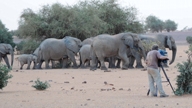HD Fujinon lens combo provides flexibility required for 'Great Migrations' shots

As a principal cinematographer on four episodes of the National Geographic series “Great Migrations,” Bob Poole captured intimate close-ups of Mali’s desert elephants, specifically a remote and dangerous herd that was difficult to film.
Poole used two Fujinon lenses, a HA25X11.5BERD HD lightweight telephoto lens and a HA13x4.5BRD HD wide-angle, ENG-style lens, to capture all of his “Great Migrations” footage. When the winds were particularly heavy, Poole often employed his TS-P58 image stabilizer from Fujinon.
“Mali elephants are terrified of vehicles, so all my filming had to be done on foot and without them knowing I was there,” Poole said. “I needed to get as close as possible, but it was too dangerous to use anything other than a long lens, except for wide shots and scenics. Between my two lenses, I had the full range covered.”
“When shooting wildlife, you have to capture behavior as it’s happening. In the past, I used a telephoto prime, and it was difficult to train the lens on the action in time. Now, with the 25x, I can zoom out to find the subject and quickly bring it back to a close-up. If I’m set up, balanced and level, I don’t miss important moments of behavior anymore.”
According to Poole, the HA25x11.5BERD telephoto lens compresses distance in a way that provides greater impact to the visuals.
“The lens has a close focus and works nicely for macro shots. I can fill the frame with an ant or with the head of a poisonous snake without getting dangerously close.”
The environmental conditions in Mali were the most challenging of Poole’s career. He experienced extreme temperatures of 125 degrees Fahrenheit in the shade and blowing sand and dust. However, the most extreme condition was the sandstorm. The HA13.4.5 wide-angle lens was able to capture the size of the oncoming sandstorm against the landscape, while the HA25x11.5BERD telephoto lens showed the speed that it was moving.
Get the TV Tech Newsletter
The professional video industry's #1 source for news, trends and product and tech information. Sign up below.
The lenses were paired with a Sony HDW-F900 HDCAM camcorder for the first half of the two-and-a-half year project, and Poole later changed to a Sony PDW-700 XDCAM.
